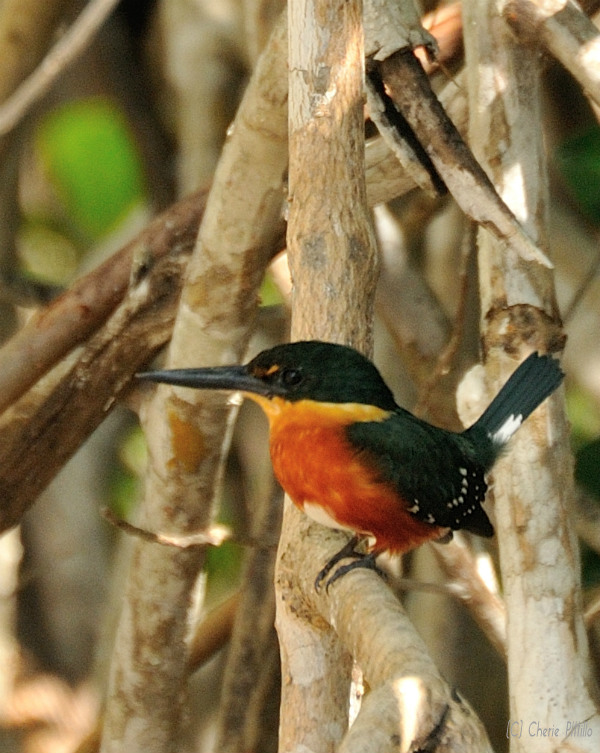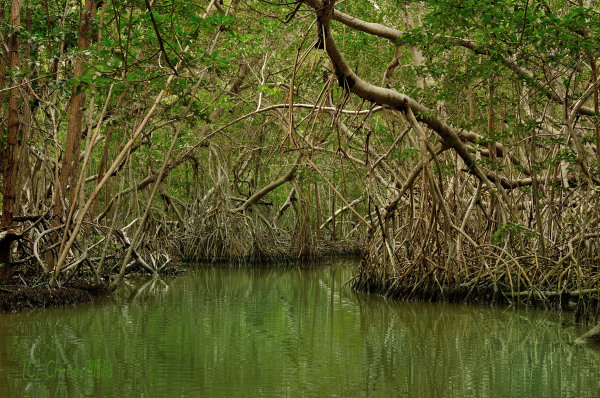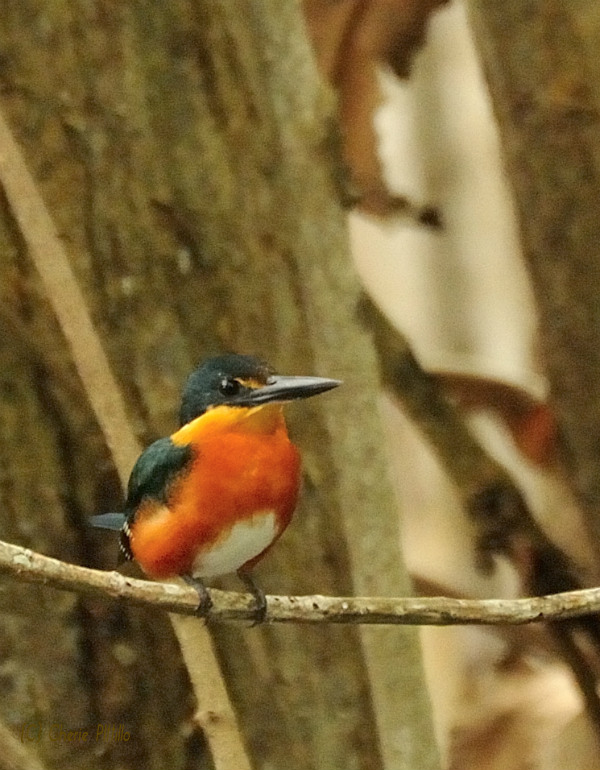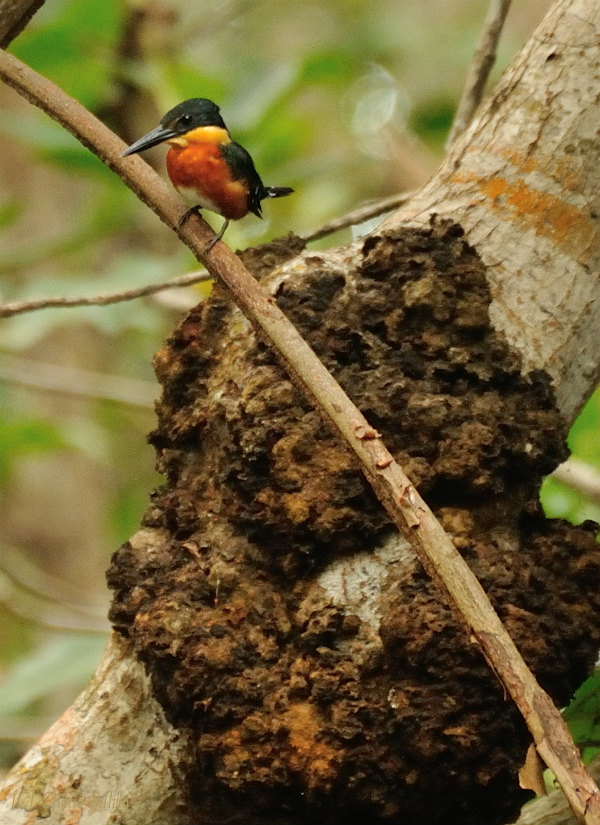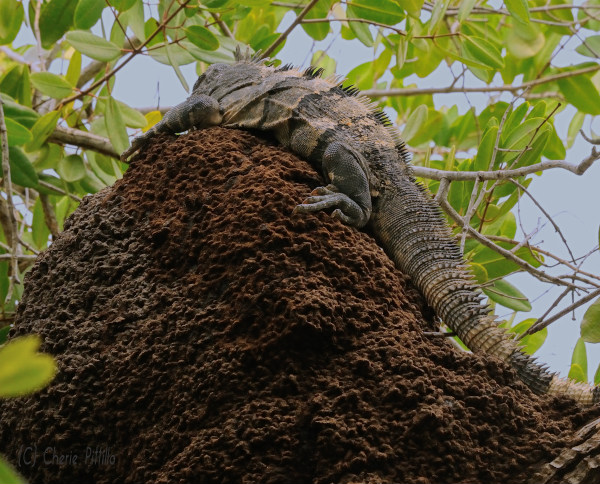Tick, tick, tick.
Tick, tick, tick.
Splash.
Listen to actual call: https://macaulaylibrary.org/audio/209876
As I stand on a boardwalk surrounded by mangrove roots, an American Pygmy Kingfisher returns to its mangrove root perch with a fish in its elongated bill. It juggles the fish until it can swallow it head first. That “tick, tick, tick” call must work. Maybe this kingfisher is a fish-whisperer.
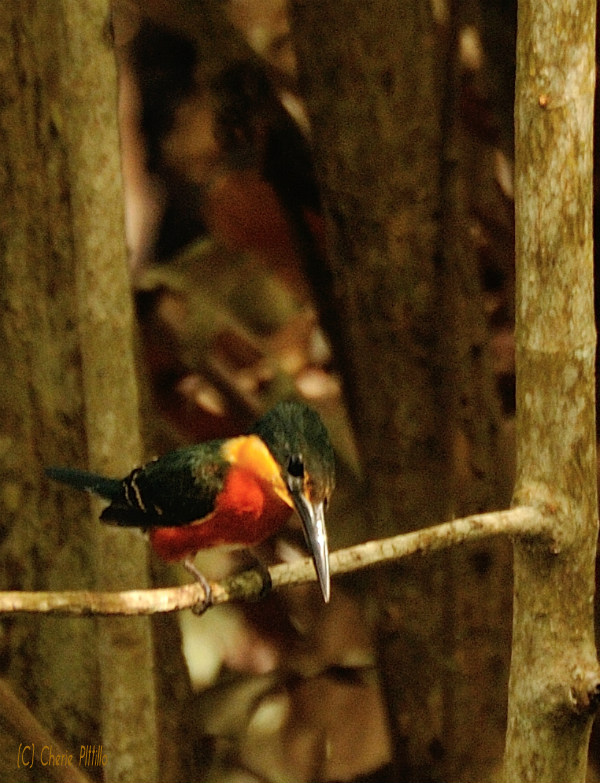
American Pygmy Kingfisher searches for fish from a perch, typical behavior for many fish eating kingfishers
That sound is quiet music to my ears. I never see enough of these 5” critters that are abundant in the Yucatan Peninsula mangroves. I can tell it’s a male because it lacks the beautiful dark green necklace of the female.
Sometimes it may be confused with the slightly larger Green Kingfisher as both share similar habitats. However the green displays an all white collar and belly and only a dark cinnamon colored chest while the female’s chest and belly are white. This is the only position I have of the green, but look at its white collar compared with the pygmy. Both are year-round residents in the peninsula.
During the Yucatan winter, the footlong, noisy Belted Kingfisher is often heard at Merida’s water parks. The photo shows a male, but guess what? The FEMALE wears a lightly buckled cinnamon belt which enlarges to cinnamon underparts. I wonder if whoever named this “belted”, assumed it was the male instead of the more colorful female “queen fisher”. When paired, they seem to scream constantly at each other. Author Mike O’Connor reckoned them “to listening to a pair of lawyers on a date.”
By the way, it seems I’ve photographed all male kingfishers. Unfortunately I don’t have any images of the 15” Ringed Kingfisher and the 11” Amazon Kingfisher also found in the peninsula.
Listen to machine gun-like or alarm clock call of the Belted Kingfisher: https://macaulaylibrary.org/audio/6561
Now hold onto your feathered caps for the next three paragraphs!
Kingfishers appear to have weak feet but two fused toes and one single toe occur on the front of each foot with one toe behind which aid in perching and also in shoveling. Kingfishers in the New World excavate 1-10 foot earthen tunnels typically near water. The monogamous kingfisher pair take turns digging with their bills for 2-3 minutes each and then uses their feet with alternate backward kicks to push out the dirt. The long burrow ends in a dome shaped chamber where eggs are laid. In the Yucatan, nests may also occur in arboreal termite nests while in the US some kingfishers make their burrows in sawdust piles or dredging spoils.
According to David Attenborough, more than two-thirds of the worldwide kingfisher family of more than 80 species don’t eat fish; they dine on insects, lizards, rodents and other land critters. Those kingfishers live on land instead of near water! Of the five species in the Yucatan, all are found at wetlands and are fisher kings and queens and mainly eat fish.
The American Pygmy feeds on fish, tadpoles, and crustaceans, but will also catch insects. And the main diet for the Green Kingfisher is fish, rarely aquatic invertebrates. Fish and other aquatic animals are ingested by the Belted Kingfisher. Each species coughs up undigestible fish scales, bones, or exoskeletons in pellets in that domed nursery chamber which makes a “prickly cradle” for the fledglings. Even a chick will back up to the chamber wall, raise up its rear end, and squirt feces onto the wall. Then it uses its bill to scratch off dirt above the feces to cover it. What a stinking nest! Maybe that’s why the kingfisher calls seem so grumpy!
GO EXCAVATE SOME ADVENTURES IN NATURE!
DISCLAIMER: References do not agree on details about this species. http://bna.birds.cornell.edu/bna/species/621/articles/introduction, Byrl J Kellog https://macaulaylibrary.org/audio/6561, Pajarear Yucatan Guia de Aves, A Guide to the Birds of Mexico and Northern Central America, Birds and Reserves of the Yucatan Peninsula, BBC David Attenborough The Life of Birds, Kaufman Lives of North American Birds, Sibley Guide to Bird Live and Behavior, The Bird Book, Birds Through an Opera Glass, Chautauqua Literary and Scientific Circle © 1889, The Armchair Birder, Why Don’t Woodpeckers Get Headaches?, Parent Birds and Their Young
Cherie Pittillo, “nature inspired,” photographer and author, explores nature everywhere she goes. She’s identified 56 bird species in her Merida, Yucatan backyard view. Her column, published on the 7th and 21st of each month, features anecdotes about birding in Merida, Yucatan and beyond. Contact: [email protected] All rights reserved, ©Cherie Pittillo

